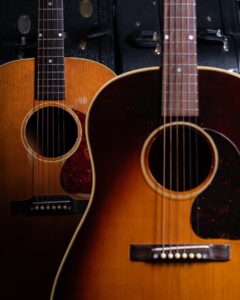Choosing the correct set of acoustic guitar strings depends on the style of music you play and the size of your acoustic guitar. There are many acoustic guitar strings, from steel to nylon.
This acoustic string set will suit acoustic guitarists who mainly strum, but they also work well for finger pickers. This set has a high-quality, smooth-feeling coating.
Steel
 Steel acoustic guitar strings have a brighter sound well-suited for rock, bluegrass and country guitarists. They also have a longer string life than nylon guitar strings. Steel strings are available in various gauges, with lighter sets (beginning at “10-47’s”) better for younger or smaller guitars. Thinner guitar strings require less effort to press down, so they’re easier on your fingertips and won’t lead to repetitive strain injuries.
Steel acoustic guitar strings have a brighter sound well-suited for rock, bluegrass and country guitarists. They also have a longer string life than nylon guitar strings. Steel strings are available in various gauges, with lighter sets (beginning at “10-47’s”) better for younger or smaller guitars. Thinner guitar strings require less effort to press down, so they’re easier on your fingertips and won’t lead to repetitive strain injuries.
Nylon acoustic guitar strings have softer, warmer tones suited for classical, flamenco, and folk guitarists. They are available in a wide range of gauges, each type of string delivering a slightly different sound. The type of string material, gauge, core, and winding type affects the tone. Choosing the correct line for your acoustic guitar requires experimentation over time. You’ll find that your signature sound comes from the combination of the ideal gauge, core, and winding type.
The size of an acoustic guitar’s soundbox is determined by the shape and proportion of its upper and lower bouts, which are the rounded parts of the body on either side of its centre line. The larger the soundbox, the more volume the guitar produces.
Acoustic guitars are built with several body styles, ranging from the parlour to the grand concert. Each has tonal qualities and characteristics, but their basic design is similar: a sound box made of wood with the treble (top) and bass (back and sides) forming mating chambers.
The top and back of an acoustic guitar are usually made of solid wood, including spruce, cedar, rosewood, mahogany, or mahogany, with a rosewood fingerboard and bridge. The neck is typically made of hardwood, such as ebony or mahogany, with a fretboard that can be metal or wood. Other components of an acoustic guitar include the soundhole, tuning pegs, and bridge.
Nylon
Nylon strings are made of plastic, making them much softer than their steel counterparts. This means they’re much less likely to cause pain or injury in your fingers, especially for beginners. They’re also much easier to hold down chords because they don’t have as much tension as steel strings.
Nylon acoustic guitar strings are often used for classical and flamenco music because they produce a warm, mellow sound. However, they’re also great for other styles of music that require a softer touch, such as jazz and bossa nova. Nylon guitar strings also tend to last much longer than steel strings because they are more durable and don’t rust.
Like steel strings, nylon strings come in different gauges (thicknesses). Low-tension strings are best for beginners because they’re more comfortable on the fingers. On the other hand, high-tension lines have a much louder and more projecting sound. Many acoustic guitarists use medium-tension strings, which balance projection and tone well.
Another important factor when choosing the type of string to use is your playing style. If you play in a manner that requires a lot of strumming or finger-picking, you might want to go with a set of high-tension strings. Nylon strings are much more flexible than steel strings, making them more responsive to your touch. This makes them better for acoustic guitars with wider necks.
Compared to steel strings, nylon guitar strings are usually less expensive. This is why they’re a popular choice for budget-conscious musicians. It’s important to remember that nylon strings require a bit more maintenance than steel strings. They must be kept clean and dry because excess sweat can make them brittle and quickly dull. Regularly changing your lines to keep them in top condition is also a good idea.
Nylon strings also squeak or rattle, especially when played with a pick. This can be a problem for some players, but it’s easy to fix with care. To prevent this, you can use a string lubricant to reduce friction between the strings and the fretboard. You can also store your guitar in a cool, dry place to avoid excessive heat and humidity, which can damage your lines.
Coated
The coated set is probably the most common type of string you’ll encounter on acoustic guitar strings. These have a polymer coating which helps to prevent the line from corroding. It also makes them easier to play with as the coating reduces string friction which can squeak when you change positions. Many guitarists find that coated strings are more durable and have a longer life than uncoated sets.






Comments are closed, but trackbacks and pingbacks are open.